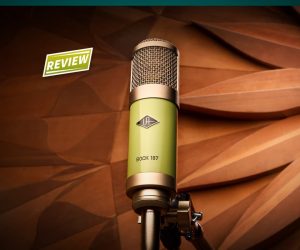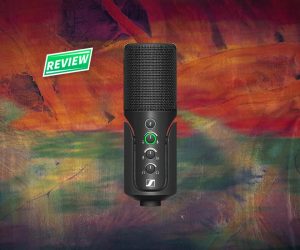
Review: Carl Martin Ampster
Finding the right amp sim doesn’t necessarily mean forsaking an analogue signal path.
With a growing reliance on VST/IR for convenient amp simulations, the Ampster is a refreshing take on the digital amp-in-a-box formula. Despite the name, Carl Martin’s diminutive 9V ‘Tube Guitar Amp-Speaker Sim DI’ pedal is a simple product with a deceptively versatile depth of use.
The unit offers a simple, practical alternative to complicated and expensive setups. It can deliver colour and character to amp-less setups when used as a DI or preamp, and presents itself as a capable alternative to VST amps when doing mic-free recording.
TOTALLY TUBED
Ampster offers a 12AX7 valve-driven preamp, a three-band EQ section, and a DI output. On top of that, the guitar amp-tuned preamp section is complemented by two ‘Cabinet’ simulation options, which are frequency response approximations of a 2×12-inch open-back, and 4×12-inch closed-back. There are then three further ‘Voicing’ variables via a switch which can help to tighten up the low end.
This device has an entirely analogue circuit doing the signal ‘processing’, resulting in genuine zero-latency audio. Latency induced by a digital/DSP stage generally isn’t a deal breaker in a live setting but can be a harrowing experience in the studio, where more precise monitoring is often required. The zero-latency of the Ampster can provide a more organic sense of performance feedback, which equates to a more engaging and pleasurable play through.
Besides the introduced latency of digital processing, simulators based on impulse responses are also inflexible. Sure, they’re able to give an exact, physically modelled replica of a specific piece of gear, but this is an immovable snapshot of an amp and cab. Conversely, you can adjust Ampster’s EQ, volume, gain, and cab options to taste — or as dictated by the room/stage sound, or the recording session’s requirements.
Aside from the cost of the modelling hardware, live rigs that are dependent on impulse responses and digital sims will also benefit from a fairly costly FRFR (full range, flat response) speaker setup, so this product is a great way to avoid these potential pricing barriers when making plans to go amp-less.
MAKING CONNECTIONS
On the back of the Ampster chassis are some interesting connection options; In, Link, DI, Send, Return, and Remote. There’s also a standard 9V 2A power socket, and a Voicing switch. The standard 6.5mm input socket takes instrument level signals, and the balanced XLR output of the DI section allows the Ampster’s affected signal to be sent to either a mixing desk or PA in a live setting, or to an interface and DAW in a studio setting.
The Link socket is the DI stage’s ‘through’ connection which outputs a pedal-bypassed signal, ready to feed an external guitar amp. Besides the usual live application, Link also makes the simultaneous recording of two tracks possible in the studio — one amped and mic’d, the other direct into the DAW.

NEED TO KNOW
Carl Martin Ampster
Tube Guitar Amp-Speaker Sim DI

The Send and Return sockets of the effects loop have a few tricks up their sleeves. The loop functions in the traditional way, by allowing ‘time’ and ‘modulation’ based effects to be injected after the preamp for better effect definition. There’s also a ‘normalling’ switch inside the Return socket. Plugging out of the ‘Send’ side alone re-routes signal through the unit, side-stepping the cab and voicing options so that it can be run as a valve preamp in front of a physical guitar amp. While this may be a novel approach to isolating the preamp stage, it may be a hindrance to those wanting to use the effects loop as intended.
The Remote socket can interface with both analogue and digital external footswitches. This option may be beneficial to users who plan on mounting the pedal under their pedalboards in a set-and-forget fashion. The Ampster can also be run on a standard centre-negative 9V DC power supply, however this won’t provide the headroom required to run a cab, for those seeking a ‘headless’ rig solution.
Finally, there’s a three-way Voicing switch controlling the roll-off of lower end content. From the ‘performance-view’, having the switch set to the centre position produces a full-range result, which suggests that it’s bypassing the section. Switching to the right, results in a gentle low end roll-off, while switching to the left shifts this adjustment range further into the mids. This is quite an effective way to clean up overly rich, or swampy guitar tones.
three layers of EQ control — the three-band EQ, two cab sim options, and three-way voicing switch — have a harmonious interplay
CLEAN MACHINE
The Ampster behaves much like a Fender Twin, having a similar responsive interaction when picking notes. It also has enough clean headroom on the input to handle densely processed signals without sounding choked. The Presence control dials in the quack nicely, adding to the performance feedback, and the Bass, Middle, and Treble of the EQ section seem well tuned in a pleasingly additive and musical way — without clouding, or detracting from each other.
With a clean guitar tone the Gain is able to dial in a gentle grit. Carl Martin’s press release suggests a “decidedly British overdrive”, hinting at a Marshall likeness. This becomes more evident once the 12AX7 sees hotter signals from pedals that can push a bit of gain. Overall, it has a nice, round low-end response, with nothing woolly or muddy sticking out. It is responsive, with a smooth picking attack that has a bright, crisp, character that is never brittle.
CABINET RESHUFFLE
The Cabinet footswitch toggles between the 2×12 open-back, and 4×12 closed-back. The selection status of these are indicated by a solid red or green LED which flashes when the pedal is muted. In the 2×12 position, the pedal adds a bright, open responsiveness to the signal, while the 4×12 mode results in a much beefier, intense performance.
These two options can be further tweaked by way of the Voicing switch, which is able to make subtle or bold adjustments to the overall signal. The left and right positions of this parameter colour the signal in a similar way to that of a close mic’d speaker when pointed at either the dust-cap or outer edge.
These three layers of EQ control — the three-band EQ, two cab sim options, and three-way voicing switch — have a harmonious interplay which make this simple, flexible unit an intuitive and effective piece of gear to use. Carl Martin has provided musicians with an enticing alternative in an increasingly DSP-centric world.
















RESPONSES